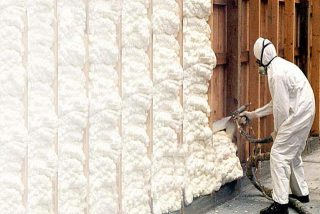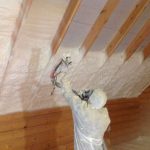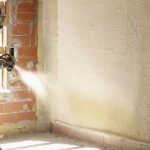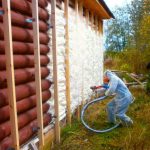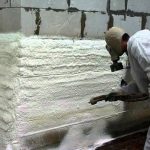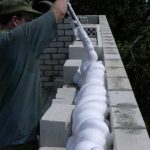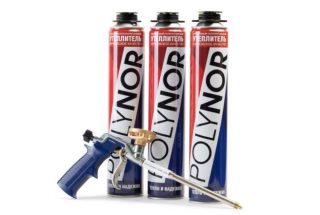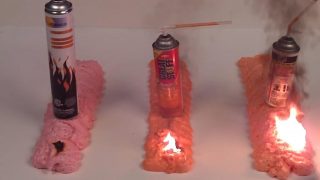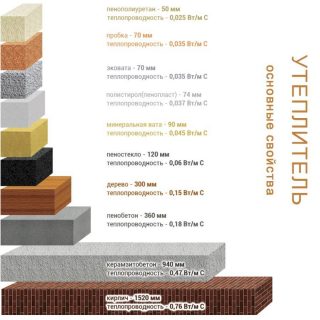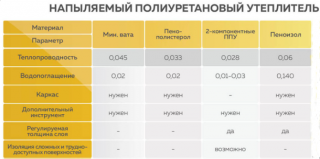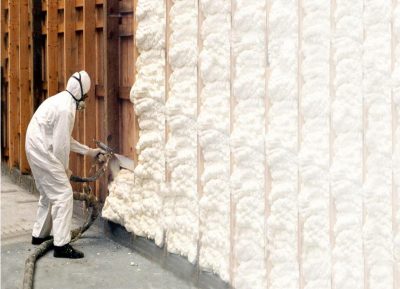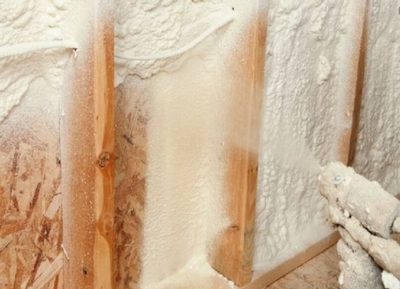Internal or external thermal insulation using foam is widely used in the arrangement of apartments and private houses. This material is suitable for wall mounting and for arranging the attic, roof space. On sale there is spray foam in cylinders and panels for building insulation.
General description of the material
- the possibility of sealing small cracks and creating a coating without seams;
- in hardened state does not create additional load on the foundation and load-bearing walls;
- no need for special fasteners: foam can be sprayed directly from the can, while it adheres well to the surface;
- decay resistance, fungal and mold colonies;
- opportunity contact with different surfaces - wooden, metal and others, while the steel does not corrode;
- the reluctance of many types of foam to burn (but here, to clarify the information, you need to pay attention to the label).
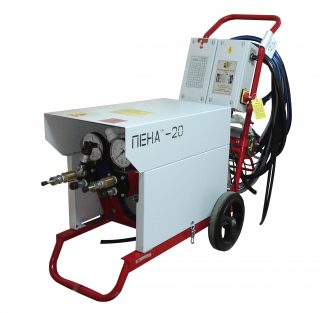
At the same time, the use of foam as insulation has and minuses:
- The material is not completely immune to environmental factors. With regular contact with water (including in a room with humid air), its structure begins to gradually deteriorate. therefore for bathrooms and similar rooms this is not the best choice... He also does not tolerate direct sunlight.
- If it is decided to insulate the surface of a large area, it is advisable work with an assistant or rent special equipment... It is much more difficult to do this alone.
- Workers who will produce insulation must have the necessary equipment - chemical protection suits, goggles, gloves.
- Exposure thermal expansion... This figure depends on the brand of the product.
- The need for a well-organized ventilation systemdue to the tendency of the foam to reduce the vapor permeability of the "pie". If ventilation is not taken care of, condensation will accumulate between the layers of materials.
Scope of application the foamy material is extensive. They are suitable for construction work in houses and apartments, in industrial premises.
Foam is used to insulate buildings from the outside and from the inside, as well as to seal all kinds of cracks through which moisture and drafts seep. It is filled with gaps in the wall layers that arise during the installation of communications. Also, the foam is suitable for thermal insulation of windows and doors.
Varieties of foam insulation
Thermal insulation foam, produced in cylinders, can be used for household and professional purposes. Household intended for small-scale renovation work - primarily for sealing gaps (for example, between a bathtub and a wall) and for use as a sealant.

Also the material differs by temperature rangeto work with which it is adapted.
- Summer foam is intended for installation and operation in rooms with air heated above +10 degrees.
- Winter - in subzero temperatures (up to -35).
- there is all-season products suitable for different environments (but not colder than -10 degrees).
Foam happens one-component and two-component... In the latter case, a second ingredient supplied in a separate container is required to polymerize the product. No water is required for this foam to cure.
- В1 - non-combustible;
- B2 - self-extinguishing;
- B3 - vulnerable to fire.
First-class products are suitable for the construction of baths, stove units and other purposes, where the lack of a tendency to fire is important.

When dealing with professional brands almost no expansion after blowing occurs. Therefore, such formulations are much more economical. Thanks to the feed control, such foam expands not in the external environment, but in the nozzle of the gun... So, in the area to be embedded or processed, the material is already deposited in a volume close to the required one. Therefore, the use of a professional product allows for more accurate work.
Criterias of choice
Besides, attention is drawn to the following characteristics:
- The ability of the material to pass moisture. For foamy products, it usually leaves a lot to be desired. The greater the vapor permeability, the less the likelihood of condensation forming, creating an environment for mold and capable of destroying building materials.
- Density, on which the insulation ability of the material depends. Its value ranges from 15 to 20 kg per cubic meter. The denser the foam, the better it insulates the room. But such products weigh more, which means that they load the supporting structures more.
- Tendency to shrink or lose shape under their own weight. If the material has this property, it is more suitable for horizontal planes (ceiling, floor) than for walls. In addition, a large number of clamping and other fixing parts will be a positive moment when working with such a heater.
- Temperature range, for operation in which the foam is intended. The ability to withstand hot air is especially important when laying material near a fireplace, stove or boiler, as well as under a roof.
- Flammability degree - Another important factor that determines the level of protection in case of accidental or purposeful fire.
Matter spatial parameters foam - the total volume that it occupies, configuration and dimensions (including when using ready-made boards). The finished molded materials have the advantage that their dimensions and shape are already known.
Wall insulation rules
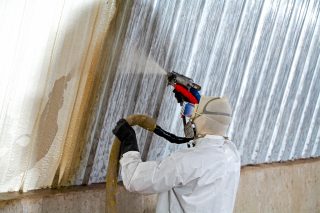
When going to work with foam materials, you need to take care of high-quality protective suit... The airway protects respirator, eyes - special glasses, hands - gloves... It is advisable that the liquid sprayed foam does not come into contact with the skin at all, otherwise the master may get a serious burn. If this does happen, the area must be thoroughly washed under running water and soap.
Surface, on which the foam will be mounted, you need dust and debris... Wet cleaning is well suited for this: this insulation adheres better to a wet surface. If it is planned to fill the area between the pipes with foam, the latter are wrapped in oilcloth material. This will help keep them from getting dirty.
Then you can proceed to foam application... You can work with the composition in cylinders two ways:
- Spraying - in this case, the foam is applied from the bottom up. Butt and corner places are processed especially carefully so that there are no gaps. If necessary, the foam can be applied in several layers so that the insulation is thick enough.
- Filling - in this case, the material is poured from top to bottom in small portions with the expectation of natural distribution within a limited volume and its filling. If during the work there are drips, they should be removed so that the surface looks neat. The areas through which the foam penetrated into the insulated zone should be sealed in order to prevent the destruction of the material under the influence of environmental factors.
If slabs have been chosen, they are installed according to the directions on the packaging.
To protect it from the action of the sun and moisture, the foam after hardening can be painted with a protective and decorative composition or sheathed with plasterboard sheets.
Specialist recommendations
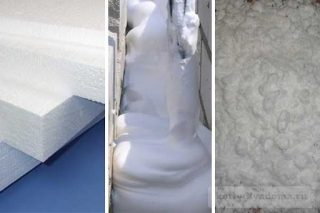
It is recommended to select the type of foam and the form of its release in accordance with the purpose and scale of work. This will help avoid a disproportionate waste of time and money.
- Liquid foam, sprayed with special equipment, well suited for thermal insulation of large areas - roof, attic, wall surfaces.
- Conventional cylinders are used for small-scale insulation and sealing operations. Polyurethane foam is well suited for sealing cracks when installing window openings and other work with cavities.
- Two-component composition, mixed clearly before use, is also recommended for windows, while it must be protected from direct sunlight. The material does not absorb moisture, is lightweight, adheres well to any surfaces. It is not eaten by rodents. All this makes it suitable for different types of work - for example, roof insulation. In this case, the foam layer should be at least 5-7 cm thick.
Suitable for filling large spaces penoizol - material produced in the form of cylinders, plates or free-flowing granules.It is used to insulate walls, ceilings, floors. They can insulate the building from the inside and outside. The only inconvenience is that penoizol freezes for a long time (up to three days).

